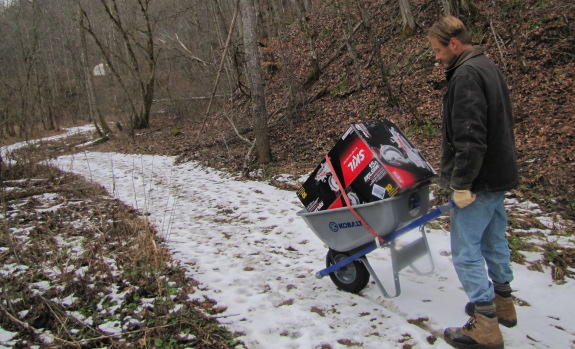
Kobalt Never Flat rolling resistance

I figured the best way to
test out the Kobalt never flat wheel barrow tire was to load it down and push
it about a quarter mile over uneven ground, across the creek and up
our little hill that proved to be
too much for the truck.
I'm not sure how to test the
rolling resistance, but it feels comparable to the old air filled one
with the added security of knowing the tire pressure is always going to
be right where it needs to be.
Want more in-depth information? Browse through our books.
Or explore more posts by date or by subject.
About us: Anna Hess and Mark Hamilton spent over a decade living self-sufficiently in the mountains of Virginia before moving north to start over from scratch in the foothills of Ohio. They've experimented with permaculture, no-till gardening, trailersteading, home-based microbusinesses and much more, writing about their adventures in both blogs and books.
Want to be notified when new comments are posted on this page? Click on the RSS button after you add a comment to subscribe to the comment feed, or simply check the box beside "email replies to me" while writing your comment.

Doing this accurately is surprisingly hard.
But for a rough indication, put some wheels under the supports of the wheelbarrow as well, and use an unster to pull the loaded wheelbarrow at a constant speed over a level and even surface (e.g. a paved road) on a day without much wind. The force registered on the unster is then the sum of the rolling resistance in the tire and the drag in the wheel bearings etc.
On even a slight incline the force necessary to overcome that will dwarf the rolling resistance, so do multiple runs in both directions and average the results.
"Een unster is een type weegschaal dat op markten verscheen in de 1ste eeuw vC." Or at least that's what wikipedia tells me...
Here's google's English translation: A spring balance is a type of scale that markets appeared in the first century BC. It consists of two arms of unequal length. On the shortest arm, the weighing merchandise hung on the longest arm hangs a weight on that arm can move freely. To a large range of weights to measure the spring balance to different brackets could be hung on the hook to light things was relatively far from the product to be weighed, serious were closer.
What I meant was a "veerunster", and I thought it was an english word originally. It seems the correct English translation is a spring scale.
It seems the correct English translation is a spring scale.